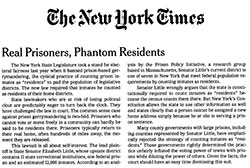Hale County, TX will avoid prison-based gerrymandering
Hale County Judge Bill Coleman will avoid prison-based gerrymandering in redrawing the district lines for the County.
by Aleks Kajstura, April 28, 2011
One more county in Texas will now avoid prison-based gerrymandering, making sure that no resident is given extra clout just because they share a district with a prison. The Plainview Daily Herald reports: County judge will not consider prison population in county redistricting:
[Hale County Judge Bill] Coleman, who began his first term in January, acknowledged that he was stunned when he learned that fact, given that prisoners are convicted felons and cannot vote, and even if they could their place of legal residence is where they are from, not where they are incarcerated.
“It made no sense to me,” Coleman said.
…
[L]ocal Census data will include local prison populations, and that data isn’t always easy to find. The result is that either by accident or through unscrupulous motive, local governmental agencies will include those numbers of ineligible voters in their redistricting plans.
While accidental inclusion is a problem…, intentional inclusion can be a way to gerrymander voting precincts to achieve a certain goal.…
For Coleman, the inclusion of the prison population in Hale County’s redistricting plan has never been an option, though. He made that clear when the issue first came up during a regular commissioners court meeting earlier this month, and he has not changed his position.
“There would be no justifiable reason for including the prison population,” he said in a recent interview.




